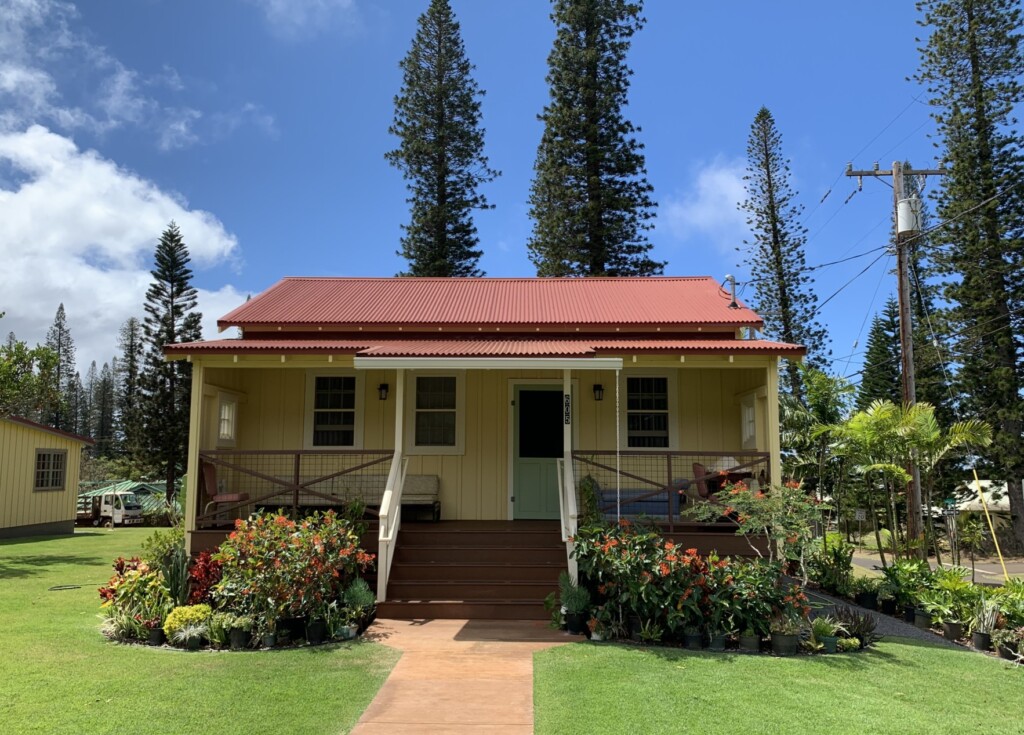
Proper painting helps extend the life of historic structures, reduces maintenance costs, and enhances the character. Image: MASON
By Principal & Historical Architect Barbara Shideler, AIA, MASON
A well-executed paint job on a vintage house enhances the historic character of the architecture through the use of appropriate colors and placement. Proper surface preparation and paint application protects the building fabric, extends the life of the structure, and reduces maintenance costs.
House paint is composed of a “vehicle”, such as oil or water; “binders” which form the film, usually an alkyd or acrylic resin; and “pigment” which provides the color, texture and hiding properties of the paint.
The most common hiding pigment is titanium dioxide which replaced lead in the 1970s. Oil-based paints provide a tough abrasion‐resistant surface that can be cleaned and hold up well in high‐traffic areas. Oil-based paints provide the best coverage, however, they are more likely to crack, fade and yellow over time. Odorous solvents like mineral spirits and turpentine are necessary for cleanup. Latex or acrylic paints exhibit excellent adhesion and better elasticity than oil. They clean up easily with soap and water. They also dry faster allowing for quick recoating; and don’t have the strong odor associated with oil‐base paints.
When repainting, consider the following:
- Spot Paint Maintenance: A homeowner should perform spot paint maintenance every 2‐3 years before the building requires a full paint job. This is accomplished by removing the original paint as it fails. Complete recoating is not done. Paint surfaces are cleaned; loose paint is knocked off; bare wood is spot primed and painted. Primers and paints should match the color and sheen of the surrounding paint. Lead containing waste may not require special disposal since smaller amounts are generated.
- Standard Paint Job: This work is typically undertaken by a painting contractor or ambitious homeowner. Remove loose paint and clean the surface; apply primer and two coats of good quality paint. Don’t complete a standard paint job more than once every 10-15 years or you’ll get heavy paint build-up that traps moisture causing accelerated paint failure
- Paint Removal and Recoat: If built‐up paint is thicker than a nickel (0.035″) and exhibits paint failure, the long‐term solution may be complete paint removal and recoating. Lead paint must be removed by a certified Contractor. Surfaces are cleaned, repaired, primed, and repainted with two-coats of good quality paint. The cost of safely removing and disposing lead paint usually makes this a last resort, however it is done once a generation. Alternatively, you can limit complete paint removal to areas where performance is required or appearance is important, such as at front doorways.
- Lead Paint Considerations: Assume paint in homes built before 1978 contains lead unless an inspection proves otherwise. Check Federal and State regulations. OSHA has rules for worker safety. EPA and State Dept of Health have rules for waste disposal. Avoid creating dust and keep occupants, particularly children, away from the work area.
- Paint Selection: When selecting paint, generally avoid thick, rubbery coatings (“elastomerics”) or coatings that compare themselves to vinyl siding since these can trap moisture leading to deterioration of the substrate. An effective paint coating will be thin enough to allow water vapor to escape from the wall. Although it appears to be counterintuitive, avoid “maintenance-free” or “permanent” coatings. It is better for a coating to be maintainable and easy to renew – like ordinary house paint.
- Paint Colors: Using historically correct paint colors will add visual richness, accentuate the architecture, and clearly reflect the building’s heritage and historic context. Several paint manufacturers have authentic historic color palettes, including: Benjamin Moore’s Historic Colors Collection; Valspar’s National Trust for Historic Preservation colors; Sherwin Williams’ Preservation Palette; and Pratt & Lambert’s Williamsburg Color Collection.
Additional resources:
- EPA Rules on Lead Paint Compatible with Best Practices for Historic Preservation (2013)
- Preservation Brief #6: Hazardous Material Abatement in Historic Buildings
- Further maintenance tips for historic property owners: Ask an Expert

